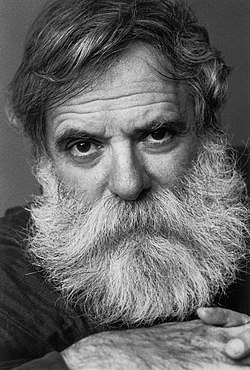Micha Bar-Am
Micha Bar-Am (* 1930 in Berlin ) is an Israeli photographer . His best-known photos are those of the Six Day War , which not so much capture the battle itself but rather everyday life during this period.
life and work
Micha Bar-Am, then still Michael Anguli, spent the first years of his childhood, from 1932, with his parents and sisters Eva and Dina in Ulm , where his father was the manager of the Wohlwert department store. As early as March 1933, the Wohlwert department store was hit by calls for a boycott by the Nazis. In 1936 the family fled to Palestine . They embarked in Trieste on the "Galilee".
Micha Mar-Am grew up in a kibbutz in Haifa and began to document kibbutz life with a borrowed camera. Active in the underground, he was drafted into the military in 1948 and a member of the Palmach . Bar-Am co-founded the Kibbutz Malkiya in the 1950s. There he worked as a welder and locksmith. After his military service, he had various jobs before he began to take serious photographs, including the war in Sinai in 1956. His pictures of the trenches in the Negev desert have become famous. After the publication of his first book, Across Sinai , he received an offer to work in the editorial department of the Israeli army magazine Bamachane , for which he worked as a photographer and writer from 1957 to 1967.
In 1959 and 1960 he was awarded the Robert Capa Award. In 1966 Bar-Am began working as a freelancer. In the same year he captured the popular image of Israel's first prime minister, David Ben Gurion , walking on a street in the evening. In 1967 he documented the Six Day War . From the mid-1960s he was together with Cornell Capa curator for several exhibitions and books, including Israel: The Reality , exhibited in 1968 at the Jewish Museum in New York , published as a book in 1970. Her project Jerusalem: city of mankind was published as a book in 1974 and was shown in 1973 and 1974 in the Israel Museum in Jerusalem and in the Jewish Museum in New York.
Micha Bar-Am has been working as a picture correspondent for Magnum since 1968 and as an Israel correspondent and chief photographer for the New York Times , for which he worked until 1992. He then went on to be the Times Middle East correspondent . In 1974 he helped Capa set up the International Center of Photography in New York and became an active curator. From 1977 to 1993 he was a photography curator at the Tel Aviv Museum of Art . His reports on Israel have appeared in numerous magazines and books. He is considered one of the chroniclers of the history of Israel.
In the USA and Israel Micha Bar-Am has been honored with major solo exhibitions, around 1975 at the Israel Museum Jerusalem, 1978 and 1981 at Beit Hatefutsot , the Nahum Goldmann Diaspora Museum Tel Aviv, and in 1982 and 1998 at the International Center founded by Cornell Capa of Photography , New York, whose collection also included some of his work. In 2000, the Ulm City Hall organized the most comprehensive exhibition of Micha Bar-Am's work in Europe to date. On this occasion he returned to the city of his childhood for the first time. In the same year he received the Israel Prize , the highest award for cultural creation in the State of Israel.
Micha Bar-Am is married to the artist Orna Bar-Am. They have three sons, Ahuvia Kahane and Barak and Nimrod Bar-Am.
Quotes
- If you get too close to the action, you lose perspective. It is not easy to be fair with the facts and to let your own beliefs out of the picture. It is almost impossible to be a participant, observer, witness and interpreter at the same time during an event.
- Today you can use words to change the meaning of images. It's not like saying that a picture is equal to 1000 words, but a picture sometimes needs a lot more than 1000 words to explain the context and content. Otherwise too much can be read into it.
Web links
- Official homepage , accessed on June 30, 2011 (eng.)
- Entries in Arthistoricum.net
Individual evidence
- ^ Birgit Huebner-Dick: Greetings from Doctor Freud. Profound messages from a hotly contested country . In: Südwest Presse . Ulm November 6, 2000.
- ^ Südwest Presse Online-Dienst GmbH: Ulm 80 years ago: How the persecution of the Jews began . In: swp.de . ( swp.de [accessed on August 14, 2017]).
- ↑ Birgit Hübner-Dick: It started with a snapshot. He came to visit for the first time as a famous photographer in more than 60 years . In: Südwest Presse . Ulm June 5, 1999.
- ^ Central Council of Jews in Germany Kdö.R .: Exhibition: Israels Bildchronist | Jewish general. Retrieved August 14, 2017 .
- ↑ a b c d Susanne Mayer: The wound that we are. Chronicler of Israel: A visit to the photographer Micha Bar Anim in Tel Aviv. In: Die Zeit , No. 27 of June 30, 2011, p. 23, accessed on July 7, 2011
- ↑ Micha Bar-Am . In: International Center of Photography . March 2, 2016 ( icp.org [accessed August 14, 2017]).
- ↑ Micha Bar-Am: Israel Diary, 1956-1982 . In: International Center of Photography . February 23, 2016 ( icp.org [accessed August 14, 2017]).
- ↑ Micha Bar-Am: An Israeli Photobiography . In: International Center of Photography . February 23, 2016 ( icp.org [accessed August 14, 2017]).
- ^ Ulm town hall. Retrieved August 14, 2017 .
| personal data | |
|---|---|
| SURNAME | Bar-Am, Micha |
| BRIEF DESCRIPTION | Israeli photographer |
| DATE OF BIRTH | 1930 |
| PLACE OF BIRTH | Berlin |
